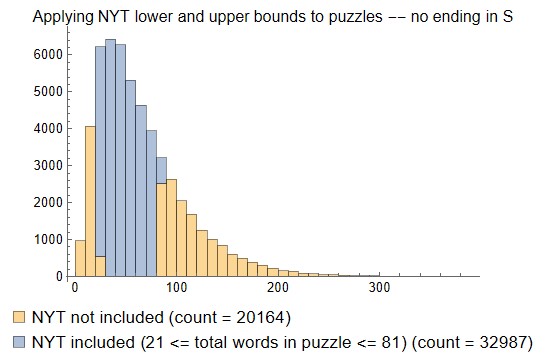JW Spelling Bee 2: Why Not Include "S"?
Why Not Include "S"?
Update 9/2/25: Today, for just the second time, the NYT Spelling Bee editor included an "S" among the 7 Spelling Bee letters.
Why did the NYT editors decide to omit S from Spelling Bee puzzles? Did they look at any data? Or did they just go by instinct?
They might have considered a basic high-school math counting principle tells us that including S increases the possible combinations of 7 letters from 480,700 (25 choose 7) to 657,800 (26 choose 7) -- an increase of 37%. But how many of those combinations are valid puzzlecombos (i.e., 7 letter combinations that yield a pangram)?
I used Mathematica to dig into the problem and determine the actual effects of including S in Spelling Bee. As it turns out, the number of puzzlecombos jumps from 4802 (with no S) to 9482, an increase of 97%. So adding S to the mix has an outsized effect on increasing the number of available puzzlecombos. This makes intuitive sense when you consider how many words contain S.
Effect of S on the Spelling Bee puzzle universe
A reminder from my previous blog that NYT has not (to date) published any puzzles with fewer than 21 words or more than 81 words. If we apply these two bounds to the data above, we get the histogram below.

Applying these bounds causes more than half of the possible puzzles to be omitted! The upper bound, in particular, takes a big bite out of the available puzzles (29,727 to be exact, vs. only 4179 for the lower bound).
Below is the same histogram for puzzles that do NOT include S. The blue bars -- which represent the "within bounds" puzzles -- total 20,819. The corresponding blue bars above total 32,468. Including S yields 56% more possible puzzles even after applying the upper and lower bounds. So the NYT could introduce more variety into the puzzles by including S and just enforcing their lower and upper bounds.
One guess at how the NYT arrived at their current situation is this: First, they decided to omit S from the puzzles, thinking "this will take care of the 'too many words in a puzzle' problem." Then someone discovered that even with omitting S, some puzzles still fell into the "too many words" trap. So they started enforcing a de facto upper bound. It was too late for them at that point to just say, "let's include S and just take care of the 'too many words' issue through an upper bound."
But all those damn plurals
Hey, NYT Puzzle Editors!
Back to unicorns and other extremes
In my previous blog, I introduced the notion of a unicorn -- i.e., puzzles with only 1 solution (the pangram). Adding S to the mix actually gives us 3 more unicorns! So here they are -- all the pangrams from unicorn puzzles:
- amphibian
- foxhound
- jukebox
- pharynx
- sixfold
- smallpox
- snuffbox
- viburnum
I think it's cool that there are only 9 words in the English language that have this property.
And what about the opposite of a unicorn? That would be this particular puzzle: adeirst (the underscored letter is the middle letter). It has a whopping 630 solution words. Some day if the NYT is feeling really cheeky, they might publish this one . . . maybe just for an hour on April Fools Day to drive the famous Steve G from Sound Beach, NY into fits. (Steve G publishes hints for all solution words every day in the comments section of Spelling Bee.)
The "stingiest" puzzlecombo is bejkoux, which has only 28 solution words in all 7 of its puzzles. At the other extreme is aeiprst, which has 3544 solution words in all 7 of its puzzles and features all of the following pangrams:
asperities, aspirate, aspirates, parasite, parasites, parities,
parties, pastier, pastries, patisserie, patisseries, piaster, piasters, pirates,
raspiest, repatriates, separatist, separatists, striptease, stripteaser, stripteasers,
stripteases, tapestries, traipse, traipses
I hope my explorations have been interesting. I welcome your feedback and ideas for future exploration!





Comments
Post a Comment